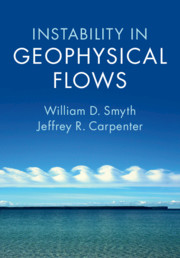
-
Select format
-
- Publisher:
- Cambridge University Press
- Publication date:
- 17 April 2019
- 11 April 2019
- ISBN:
- 9781108640084
- 9781108703017
- Creative Commons:
-
This content is Open Access and distributed under the terms of the Creative Commons Attribution licence CC-BY-NC-ND 4.0.
https://creativecommons.org/creativelicenses - Dimensions:
- Weight & Pages:
- Dimensions:
- (244 x 170 mm)
- Weight & Pages:
- 0.86kg, 340 Pages
Open AccessYou have digital access to this book
Book description
Instabilities are present in all natural fluids from rivers to atmospheres. This book considers the physical processes that generate instability. Part I describes the normal mode instabilities most important in geophysical applications, including convection, shear instability and baroclinic instability. Classical analytical approaches are covered, while also emphasising numerical methods, mechanisms such as internal wave resonance, and simple `rules of thumb' that permit assessment of instability quickly and intuitively. Part II introduces the cutting edge: nonmodal instabilities, the relationship between instability and turbulence, self-organised criticality, and advanced numerical techniques. Featuring numerous exercises and projects, the book is ideal for advanced students and researchers wishing to understand flow instability and apply it to their own research. It can be used to teach courses in oceanography, atmospheric science, coastal engineering, applied mathematics and environmental science. Exercise solutions and MATLAB® examples are provided online. Also available as Open Access on Cambridge Core.
Reviews
'Written with impressive clarity, this new textbook covers all the key types of geophysical instability and provides a window to more advanced topics such as transient optimal growth and transition to turbulence. In addition to presenting the mathematical fundamentals the authors present satisfying physical explanations for the complex mechanisms, while throughout the text (and homework exercises) numerical methods and simple codes are used to familiarise students with this important tool for simulating instability mechanisms numerically. For all these reasons it is truly an outstanding textbook - for class teaching or self-study. I will use it myself to create a new graduate course!'
Eyal Heifetz - Tel Aviv University
‘… large number of analytical and numerical exercises, make the book suitable for use in teaching a graduate or upper-level undergraduate course on the subject of geophysical fluid dynamics. The material covered would be helpful both to atmospheric science students and researchers who wish to understand the mathematical theory and numerical simulation techniques and to applied mathematics students and researchers who wish to learn more about the geophysical processes and the mechanisms that lead to the instabilities.’
Lucy J. Campbell Source: Mathematical Reviews Clippings
Contents
Full book PDF-
Frontmatter
pp i-iv -
-
- You have access
- Open access
- Export citation
-
-
Contents
pp v-viii -
-
- You have access
- Open access
- Export citation
-
-
Preface
pp ix-x -
-
- You have access
- Open access
- Export citation
-
-
Acknowledgments
pp xi-xii -
-
- You have access
- Open access
- Export citation
-
-
Part I - Normal Mode Instabilities
pp 1-2 -
-
- You have access
- Open access
- Export citation
-
-
1 - Preliminaries
pp 3-23 -
-
- You have access
- Open access
- Export citation
-
-
2 - Convective Instability
pp 24-52 -
-
- You have access
- Open access
- Export citation
-
-
3 - Instabilities of a Parallel Shear Flow
pp 53-106 -
-
- You have access
- Open access
- Export citation
-
-
4 - Parallel Shear Flow: the Effects of Stratification
pp 107-136 -
-
- You have access
- Open access
- Export citation
-
-
5 - Parallel Shear Flow: the Effects of Viscosity
pp 137-152 -
-
- You have access
- Open access
- Export citation
-
-
6 - Synthesis: Viscous, Diffusive, Inhomogeneous, Parallel Shear Flow
pp 153-173 -
-
- You have access
- Open access
- Export citation
-
-
7 - Nonparallel Flow: Instabilities of a Cylindrical Vortex
pp 174-194 -
-
- You have access
- Open access
- Export citation
-
-
8 - Instability in a Rotating Environment
pp 195-221 -
-
- You have access
- Open access
- Export citation
-
-
9 - Convective Instability in Complex Fluids
pp 222-241 -
-
- You have access
- Open access
- Export citation
-
-
10 - Summary
pp 242-244 -
-
- You have access
- Open access
- Export citation
-
-
Part II - The View Ahead
pp 245-246 -
-
- You have access
- Open access
- Export citation
-
-
11 - Beyond Normal Modes
pp 247-261 -
-
- You have access
- Open access
- Export citation
-
-
12 - Instability and Turbulence
pp 262-272 -
-
- You have access
- Open access
- Export citation
-
-
13 - Refining the Numerical Methods
pp 273-286 -
-
- You have access
- Open access
- Export citation
-
-
Appendix A - Homework Exercises
pp 287-306 -
-
- You have access
- Open access
- Export citation
-
-
Appendix B - Projects
pp 307-316 -
-
- You have access
- Open access
- Export citation
-
-
References
pp 317-322 -
-
- You have access
- Open access
- Export citation
-
-
Index
pp 323-328 -
-
- You have access
- Open access
- Export citation
-
Metrics
Altmetric attention score
Full text views
Full text views help Loading metrics...
Loading metrics...
* Views captured on Cambridge Core between #date#. This data will be updated every 24 hours.
Usage data cannot currently be displayed.
Accessibility standard: Unknown
Why this information is here
This section outlines the accessibility features of this content - including support for screen readers, full keyboard navigation and high-contrast display options. This may not be relevant for you.
Accessibility Information
Accessibility compliance for the PDF of this book is currently unknown and may be updated in the future.


